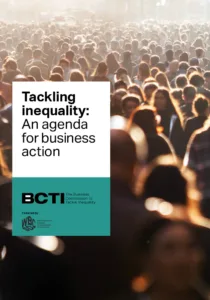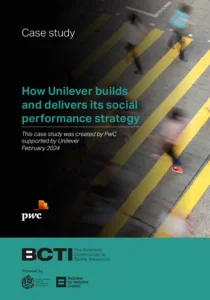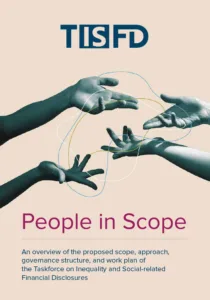

Societal challenges affect communities, companies, economies, and entire societies. The BCTI Flagship Report highlights stark inequalities in income, wealth and well-being: the richest 10% of the world’s population holds over 75% of all wealth, while the poorest 50% owns just 2%. Economic inequality is compounded by disparities in health, education, and other areas. The climate crisis further strains economies and well-being, while rapid technological advances present both risks and opportunities, adding complexity for business. Addressing these challenges requires fresh perspectives and proactive measures from companies.
Many companies miss out on opportunities to create greater business value through stronger social performance because they lack the vision and insights. At the same time, there is ongoing pressure from society and regulators for companies to be transparent about their impact on people and society. This creates a pressing need for businesses to understand their social impacts, risks and opportunities and leverage this data to improve decision making and performance.
Risk mitigation: Proactively managing social performance helps avoid reputational damage, financial penalties from social washing, supply chain disruptions, and loss of market share.
Competitive advantage: Strong social performance enhances resilience, brand loyalty, and innovation, supporting long-term success.
Stakeholder value: Demonstrating commitment to social accountability and measuring progress through auditable, sustainable practices builds trust with customers, investors, and regulators, and drives growth.
Financial and social impact: Aligning financial returns with broader socio-economic benefits fosters long-term behavioral and strategic change.
The inside-out perspective looks at how a company’s operations influence society, for example through its labor practices, and diversity, equity and inclusion efforts. The outside-in perspective examines how external factors affect the financial position, performance or growth. By double materiality – considering both internal impacts and external risks – businesses can identify opportunities and vulnerabilities, enabling a more balanced, sustainable, and performance-driven social strategy.
Note: The information and approaches outlined in this practical guidance are intended for informational and educational purposes only and are designed from a social sustainability strategy perspective. While we have incorporated elements of recognized reporting standards like the double materiality concept that the reader may be familiar with, these are not necessarily aligned with and do not represent mandatory reporting requirements or legal obligations under any applicable laws or regulations. Users are encouraged to consult with legal or regulatory professionals to ensure compliance with relevant reporting standards and practices.
Effects on the economy, environment, and people, including human rights. Impacts can be actual or potential, positive or negative, short-term or long-term, intended or unintended, and either reversible or irreversible.
Uncertain environmental, social, economic or governance events that could negatively affect the business model, strategy, sustainability targets, and overall value creation.
Uncertain environmental, social, economic or governance factors that could positively affect the business model, strategy, sustainability targets, and overall value creation.
By incorporating outside-in risks and opportunities, the Business Value and Social Performance Approach builds a pathway that provides an in-depth view of the impacts, risks, and opportunities that businesses face. It supports companies in identifying the drivers behind the IROs and promotes social sustainability while enhancing business value through the integration and measurement of social performance and accountability.
Paypal increased profits by 28%, partly by raising wages and reducing healthcare costs for hourly and entry-level employees, ensuring they can meet their financial obligations and access medical care. After engaging with PayPal’s lowest-paid employees, the CEO recognized wages were insufficient and decided to raise them. While growth is partly attributed to increased e-commerce revenue, evidence shows that ensuring employees earn enough to alleviate financial fear boosts productivity and loyalty.
In 2014, IKEA adopted a living wage and decided to adjust wages annually based on living costs. This led to a 5% decrease in staff turnover, and earned the company recognition as a Great Place to Work, as well as a spot among Fortune Magazine’s Top 100 Employers.
Costco believes that hiring good people, providing good jobs, paying good wages, and offering good career opportunities leads to positive business outcomes. The company boasts an employee turnover rate under 10%, which drops to below 6% after an employee’s first year. This demonstrates that paying good wages not only retains staff but also boosts productivity.
Unilever Pakistan determined that a monthly living wage amounting to Rs 60,000 (approximately USD 215) was enough to have a decent life free from financial worries. The company observed that more experienced workers delivered better results. As a result, it doubled the wages of these employees over three years in addition to covering their medical and education expenses. This investment led to a significant reduction in the attrition rate, from 40% to 4%, and increased sales.
"As Unilever, our size and scale come with a responsibility and a significant opportunity to have a possible impact on people. We are firmly committed to promoting human rights and improving livelihoods across our value chain. By identifying the biggest risks, opportunities and impacts for the people in our value chain, we are able to improve their living standards while also strengthening our business success and resilience" Source: Unilever
The first step in integrating and measuring social accountability and performance is to establish a baseline social strategy and prioritize key action areas. This will enable your business to identify its strategic position in social sustainability. By using questions provided in the figure below, you can identify the sweet spot where your initiatives, operations, and strategic priorities intersect.
The second step focuses on identifying the IROs for the sustainability topics you selected in Step 1. Thise IRO exercise may also provide additional insights into topics you have missed in Step 1. You should assess the materiality of each impact, risk, and opportunity from both a social and financial perspective.
The third step helps determine the scope of the I&FE Pathway. Decide how extensively to address the selected social issues and whether to include related social sustainability impacts. A broader scope offers greater social impact and stronger alignment with sustainability goals, but requires more resources and coordination. A narrower scope is easier to implement and monitor, but may limit strategic value and overall impact.
Owners of the I&FE Pathway can include representatives from the Sustainability team with support from the Data team.
A clear scope for the I&FE Pathway, which helps to focus efforts and resources effectively
In the Living Wage example, this process has been simplified to present three potential scopes. The narrowest scope is limited to paying a living wage to the organization’s direct employees, while the broadest scope extends living wages to all employees across the entire value chain, both upstream and downstream.
In the previous three steps, you identified the social topics to focus on, analyzed their impacts, risks, and opportunities (from both a social and financial perspective) from business activities, and defined their scope. In this step, you will define cause-and-effect relationships that lead to monetized effects – both in terms of social impact and financial performance.
An I&FE Pathway for the defined action areas that provides an end-to-end overview of monetized effects from identified IROs, including both business activities and the external operating environment
In the previous three steps, you identified the social topics to focus on, analyzed their impacts, risks, and opportunities (from both a social and financial perspective) from business activities, and defined their scope. In this step, you will define cause-and-effect relationships based on identified IROs that lead to monetized effects – both in terms of social impact and financial performance.
A set of metrics derived from the I&FE Pathway to inform and steer the business in line with its social strategy
In today’s evolving business landscape, integrating double materiality and measuring both impact and financial effects is a strategic imperative. Adopting structured frameworks such as the Impact and Financial Effect Pathway can help businesses effectively map and manage social impacts, mitigate risks, and unlock new opportunities for innovation, growth and business value. Aligning these strategies with broader sustainability goals not only enhances operational effectiveness, but also builds trust with stakeholders and drives long-term value creation and competitiveness.
Now is the time for decisive action. We invite you to explore our tools and resources, designed to guide your organization through every step of this journey.

Explore our BCTI flagship report to learn more about the business case for addressing inequality and advancing the social agenda for private sector action. The report features best practices from industry peers and offers valuable insights to inform executive decision making and strengthen the business case for enhanced social performance.

Read our case study showcasing how Unilever builds and delivers its social performance strategy. The case provides insights into effective strategies for addressing inequality in the private sector.

Explore our interactive e-learning course designed to help businesses strengthen recruitment practices for migrant workers. This tool offers insights into stakeholder engagement across the supply chain and helps identify strategies and actions that align with your organization’s needs and objectives.

Learn how the TISFD can help your business address impacts, dependencies, risks, and opportunities related to people. Review TISFD’s publications on Proposed Technical Scope and People in Scope to gain valuable insights. Engage with the TISFD to promote transparency, learn and adopt best practices, and collaborate with peers to amplify social impact and boost business performance.
Reach out to the WBCSD’s Equity Action team to explore how we can work with you on your broader social agenda including Just Transition, Living Wage, and Human Rights.
Reach out to PwC’s Social Sustainability services team to get in touch about how businesses can utilize the I&FE Approach to drive social and business performance by leveraging insights from their social sustainability performance data